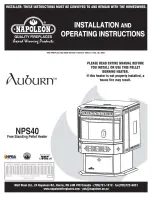
138
ENGLISH
fixing screws
2) Remove the upper and side wooden cage
3) Remove any wrapping
4) Remove the appliance from the pallet and
position the appliance in the chosen location,
ensuring that it is compliant with the directions.
Use suitable equipment to remove the boards or
wooden parts of packing.
The end user is responsible for disposing of the
packaging in accordance with the laws in force
in the country of installation.
6.2
SET-UPS FOR THE SMOKE
EVACUATION SYSTEM
Be careful when building the smoke evacuation
system and observe the regulations in force in
the country where the appliance is installed.
The Manufacturer will not be held liable for
incorrectly sized and non-regulation smoke
evacuation systems.
6.2.1
Smoke ducts and fittings
The term smoke duct indicates all ducts that
connect the combustion equipment to the
chimney.
The following requirements need to be applied:
• observe product standard EN 1856-2;
• the horizontal sections must have a minimum
slope of 3% upwards;
• the length of the horizontal section must be as
minimum as possible, and its projection on the
horizontal plane must not exceed 2 metres;
• changes in direction must not have an angle of
more than 90° (45° bends are recommended);
• the number of direction changes, including the
one necessary for insertion into the chimney,
must not exceed 3;
• the cross section must have a constant
diameter, the same from where it exits the
firebox up to the fitting into the chimney;
• it is forbidden to use flexible metal and fibre
cement pipes;
• smoke ducts must not cross rooms where
the installation of combustion equipment is
prohibited.
In any case, the smoke ducts must be sealed
against combustion products and condensation,
as well as insulated if they lead outside of the
installation room.
Installing manual draught adjustment devices is
not allowed.
6.2.2 Chimney
The chimney is a particularly important element
for correct stove operation.
The chimney must be sized so as to guarantee
the draught declared by the Manufacturer.
Do not connect the stove to a collective chimney.
The chimney must be built applying the following
regulations:
• it must observe product standard EN 1856-1;
• it must be made of materials that are suitable
to guarantee resistance against normal
mechanical, chemical and thermal stress and
be correctly thermally insulated to limit the
formation of condensation;
• it must be mainly vertical and not feature any
bottlenecks along its entire length;
• it must be correctly spaced with an air gap and
insulated from flammable materials;
• there must be a maximum of 2 changes in
direction and angles must not exceed 45°;
• the chimney inside the home, however, must
be insulated and can be inserted into a skylight
shaft, as long as it respects standards regarding
placing inside a tube;
• the smoke conduit must be connected to the
chimney using a “T” fitting with an inspection
collection chamber for combustion residue
and especially for collecting condensation.
It is necessary to check the safety distances that
need to be observed when there are flammable
materials and the type of insulating material that
needs to be used is on the chimney data plate.
Use watertight pipes with silicone seals.
It is forbidden to use the discharge mounted
directly on the wall or directed towards indoor
spaces and any other type of discharge that is not
set forth by the regulation in force in the country
of installation (Note: in Italy only roof-discharge
is allowed).
6.2.3 Chimney pot
The chimney pot, i.e. the top end of the chimney,
must fulfil the following characteristics:
• the cross-section of the smoke outlet must be
at least twice the internal cross-section of the
chimney;
• it must stop water or snow from getting in;
• make sure the smoke is taken away even when
there is wind (wind resistant chimney pot);
• the outlet height must be outside of the reflux
zone (refer to national and local regulations to
calculate the reflux zone);
• it must always be built at a distance from
antennas or dishes, it must never be used as
support.
6.3 INSTALLATION
For appliance installation and use it is necessary
to observe all of the local, national and European
laws and regulations.
Appliance installation and the preparation of the
building work must observe the regulation in
force in the country of installation (ITALY = UNI
10683).
The installation activities must be carried out by
a technician that is qualified and/or authorised
by the Manufacturer. The staff in charge of
installation must issue a declaration of conformity
of the system to the buyer, whereby they take full
responsibility for the final installation and good
operation of the installed product.
There shall be no liability on the part of Ravelli if
these precautions are not observed.
6.3.1 Requirements for the installation
premises
The appliance installation room must be
sufficiently ventilated. To fulfil this requisite it is
necessary to equip the room with an air intake
connected to the outdoors.
The installation room must have an air intake
with a free cross-section of at least 80 cm
2
in
case of boiler.
For installation in the presence of other
combustion appliances or VMC system it is
necessary to check the appliance for correct
operation.
The appliance must be placed inside living
Содержание BLOCK 7 STONE
Страница 26: ...26 ITALIANO Fig 8 28 Fig 8 29 Fig 8 30 Fig 8 31...
Страница 88: ...88 FRANCAIS Fig 8 28 Fig 8 29 Fig 8 30 Fig 8 31...
Страница 149: ...149 ENGLISH Fig 8 28 Fig 8 29 Fig 8 30 Fig 8 31...
Страница 187: ...187 ENGLISH...
Страница 190: ......
Страница 191: ......
















































